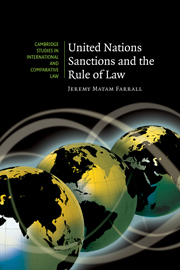Book contents
- Frontmatter
- Contents
- Extended Table of Contents
- Preface
- Abbreviations
- Part I Setting the scene
- Part II The evolution of the UN sanctions framework
- Part III UN sanctions in practice
- 5 Establishing the legal basis for sanctions: identifying threats and invoking Chapter VII
- 6 Delineating the scope of sanctions and identifying targets
- 7 Fine-tuning sanctions: setting objectives, applying time-limits and minimising negative consequences
- 8 Delegating responsibility for sanctions administration and monitoring
- Part IV Strengthening the rule of law
- Appendix 1 Summary of policy recommendations
- Appendix 2 Summaries of UN sanctions regimes
- Appendix 3 Tables
- Bibliography
- Index
- Cambridge Studies in International and Comparative Law
5 - Establishing the legal basis for sanctions: identifying threats and invoking Chapter VII
Published online by Cambridge University Press: 26 June 2009
- Frontmatter
- Contents
- Extended Table of Contents
- Preface
- Abbreviations
- Part I Setting the scene
- Part II The evolution of the UN sanctions framework
- Part III UN sanctions in practice
- 5 Establishing the legal basis for sanctions: identifying threats and invoking Chapter VII
- 6 Delineating the scope of sanctions and identifying targets
- 7 Fine-tuning sanctions: setting objectives, applying time-limits and minimising negative consequences
- 8 Delegating responsibility for sanctions administration and monitoring
- Part IV Strengthening the rule of law
- Appendix 1 Summary of policy recommendations
- Appendix 2 Summaries of UN sanctions regimes
- Appendix 3 Tables
- Bibliography
- Index
- Cambridge Studies in International and Comparative Law
Summary
In its role as the creator and overseer of UN sanctions, the Security Council shapes the parameters of each sanctions regime. When the Security Council imposes a new sanctions regime, it generally identifies a threat to or breach of international peace and security, before invoking Chapter VII of the Charter as the basis for action. The Council then delineates the scope of the measures to be applied and identifies the particular state, group or individuals against which sanctions are to be applied. The Council has also taken a number of additional steps to fine-tune sanctions application. It has clarified the objectives of sanctions, setting conditions whose fulfilment will lead to the suspension or termination of sanctions. It has outlined exemptions from the sanctions regime and determined the temporal application of the sanctions, stipulating whether sanctions were subject to a time-limit or would come into force immediately or after a time-delay.
The Security Council has generally delegated responsibility for the day-to-day administration of its new sanctions regimes to a subsidiary organ, most often a sanctions committee that is created expressly for that purpose. The Council has also established other sanctions-related subsidiary bodies, including Panels of Experts, Monitoring Mechanisms and Special Commissions, to administer and monitor the implementation of sanctions. These subsidiary bodies generally undertake responsibilities that are specific to an individual sanctions regime, rather than having a broader, system-wide focus connected with the implementation of sanctions in general.
- Type
- Chapter
- Information
- United Nations Sanctions and the Rule of Law , pp. 81 - 105Publisher: Cambridge University PressPrint publication year: 2007



